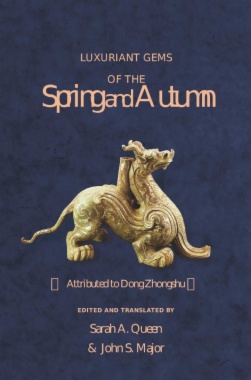The Spring and Autumn (Chunqiu) is a chronicle kept by the dukes of the state of Lu from 722 to 481 B.C.E. Luxuriant Gems of the "Spring and Autumn" (Chunqiu fanlu) follows the interpretations of the Gongyang Commentary, whose transmitters sought to explicate the special language of the Spring and Autumn. The work is often ascribed to the Han scholar and court official Dong Zhongshu, but, as this study reveals, the text is in fact a compendium of writings by a variety of authors spanning several generations. It depicts a utopian vision of a flourishing humanity that they believed to be Confucius's legacy to the world.
The Gongyang masters thought that Confucius had written the Spring and Autumn, employing subtle phrasing to indicate approval or disapproval of important events and personages. Luxuriant Gems therefore augments Confucian ethical and philosophical teachings with chapters on cosmology, statecraft, and other topics drawn from contemporary non-Confucian traditions. A major resource, this book features the first complete English-language translation of Luxuriant Gems, divided into eight thematic sections with introductions that address dating, authorship, authenticity, and the relationship between the Spring and Autumn and the Gongyang approach. Critically illuminating early Chinese philosophy, religion, literature, and politics, this book conveys the brilliance of intellectual life in the Han dynasty during the formative decades of the Chinese imperial state.
- Table of Contents
- Acknowledgments
- Introduction
- Group 1: Exegetical Principles
- 1. King Zhuang of Chu
- 2. Jade Cup
- 3. Bamboo Grove
- 4. Jade Brilliance
- 5. The Quintessential and the Ornamental
- 6. The Kingly Way
- 7. Annihilated States, Part A
- 8. Annihilated States, Part B
- 9. Waxing and Waning in Accord with the Root
- 10. The Essentials of Covenants and Meetings
- 11. The Rectifying Thread
- 12. Ten Directives
- 13. Emphasize Governance
- 14. Images for the Regulation of Dress
- 15. Two Starting Points
- 16. Signs and Omens
- 17. Yu’s Postface
- Group 2: Monarchical Principles
- 18. Departing from and Conforming to the Fundamental
- 19. Establishing the Originating Spirit
- 20. Preserving Position and Authority
- 21. Investigating Achievement and Reputation
- 22. Comprehending the State as the Body
- Group 3: Regulatory Principles
- 23. The Three Dynasties’ Alternating Regulations of Simplicity and Refinement
- 24. Regulations on Officialdom Reflect Heaven
- 25. Yao and Shun Did Not Presumptuously Transfer [the Throne]; Tang and Wu Did Not Rebelliously Murder [Their Rulers]
- 26. Regulations on Dress
- 27. Regulating Limits
- 28. Ranking States
- Group 4: Ethical Principles
- 29. Standards of Humaneness and Righteousness
- 30. The Necessity of [Being] Humane and Wise
- 31. For Nurturing the Self, Nothing Is More Important Than Righteous Principles
- 32. An Official Response to the King of Jiangdu: The Great Officers of Yue Cannot Be Considered Humane
- 33. Observing Virtue
- 34. Serving the Root
- 35. Deeply Examine Names and Designations
- 36. Substantiating Human Nature
- 37. The Lords of the Land
- 38. An Official Response Regarding the Five Phases
- 39. [Title and text are no longer extant]
- 40. [Title and text are no longer extant]
- 41. Heaven, the Maker of Humankind
- 42. The Meaning of the Five Phases
- Group 5: Yin-Yang Principles
- 43. Yang Is Lofty, Yin Is Lowly
- 44. The Kingly Way Penetrates Three
- 45. Heaven’s Prosperity
- 46. The Heavenly Distinctions Lie in Humans
- 47. The Positions of Yin and Yang
- 48. Yin and Yang End and Begin the Year
- 49. The Meaning of Yin and Yang
- 50. Yin and Yang Emerge, Withdraw, Ascend, and Descend
- 51. Heaven’s Way Is Not Dualistic
- 52. Heat or Cold, Which Predominates?
- 53. Laying the Foundation of Righteousness
- 54. [Title and text are no longer extant]
- 55. The Correlates of the Four Seasons
- 56. Human Correlates of Heaven’s Regularities
- 57. Things of the Same Kind Activate One Another
- Group 6: Five-Phase Principles
- 58. The Mutual Engendering of the Five Phases
- 59. The Mutual Conquest of the Five Phases
- 60. Complying with and Deviating from the Five Phases
- 61. Controlling Water by Means of the Five Phases
- 62. Controlling Disorders by Means of the Five Phases
- 63. Aberrations of the Five Phases and Their Remedies
- 64. The Five Phases and Five Affairs
- Group 7: Ritual Principles
- 65. Sayings Pertaining to the Suburban Sacrifice
- 66. The Principles of the Suburban Sacrifice
- 67. Sacrificial Rites of the Suburban Sacrifice
- 68. The Four [Seasonal] Sacrificial Rites
- 69. The Suburban Sacrifice
- 70. Following Orders
- 71. An Official Response Regarding the Suburban Sacrifice
- 72. Presenting Gifts to Superiors
- 73. Hymn to the Mountains and Rivers
- 74. Seeking Rain
- 75. Stopping Rain
- 76. The Principles of Sacrificial Rites
- Group 8: Heavenly Principles
- 77. Conform to Heaven’s Way
- 78. The Conduct of Heaven and Earth (Lau version)
- 78A. The Conduct of Heaven and Earth (Su Yu version)
- 79. The Origins of Severity and Beneficence
- 80. In Imitation of Heaven’s Activities (Lau version)
- 80A. In Imitation of Heaven’s Activities (Su Yu version)
- 81. Heaven, Earth, Yin, and Yang (Lau version)
- 81A. Heaven, Earth, Yin, and Yang (Su Yu version)
- 82. The Way of Heaven Bestows (Lau version)
- 82A. The Way of Heaven Bestows (Su Yu version)
- Appendix A. Biographies of the Confucian Scholars
- Appendix B. The Biography of Dong Zhongshu
- Selected Bibliography
- Index

